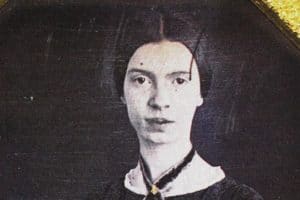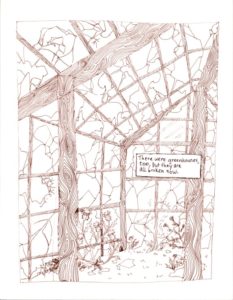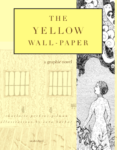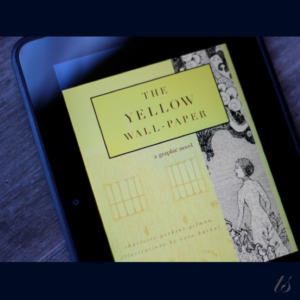Editor’s Note: Our book clubs are regularly set aside as exclusive experiences, as thanks to our Patrons, whose generosity helps us bring wisdom, kindness, and joy to the world.
Today, we hope you’ll enjoy this edition of The Yellow Wall-Paper book club, as our National Poetry Month gift to you—a piece that ordinarily would have been for patrons only.
***
The classic picture of Emily Dickinson, the one you’ve seen, has a triangle of yellow in the top right corner. It’s as if the iconic American poet is looking at us through a hole in the wallpaper. Perhaps she is.
The more I read the graphic novel edition of Charlotte Perkins Gilman’s The Yellow Wall-Paper, taking time with Sara Barkat’s illustrations, the more I think of Dickinson. Like our unnamed narrator, she is imaginative, she is witty, she is reclusive, she is puzzling.
Here is the first stanza from one of Dickinson’s best-known poems:
“Hope” is the thing with feathers –
That perches in the soul –
And sings the tune without the words –
And never stops – at all –
—Emily Dickinson
Our narrator — who for the rest of the book club I will refer to as Our Lady — comes to her summer getaway full of hope. This “ancestral hall,” this “colonial mansion,” this “hereditary estate” is supposed to cure her of an unspecified sickness. She tries to not mind the broken greenhouses, the barred windows, the scratches on the floor that look like they were made by a wild animal, and the bed nailed to the floor. She’s not at all sure this place will help her, but maybe it will.
She is a lovely Victorian lady of her time. We know she writes. We know she’s had a baby. We know she has an active mind — she fancies people walking the paths around the house, and as a child she saw the bureau almost wink. We know she studies this wallpaper as no one has studied it before.
Her husband, John, is a doctor, by training, and a creep, by character. Sara Barkat draws him confident and smarmy, like a white-collar criminal.
Barkat’s illustrations mix the proper with the bizarre: proper feminine attire alongside a bizarre wallpaper pattern with “lame uncertain curves” that “suddenly commit suicide—plunge off at outrageous angles, destroy themselves in unheard of contradictions.” On one page “unblinking eyes are everywhere,” and on the next, stately furniture.
Our Lady begins this story anticipating that she will get better, that her husband loves her and wants the best for her. But unlike the hope described in Dickinson’s poem, something will be asked of this woman. She’ll need to come in full contact with her “ghostliness,” which is her strength.
He says that with my imaginative power and habit of story-making, a nervous weakness like mine is sure to lead to all manner of excited fancies, … so I try”
Our Lady will try and keeps trying. By the end of this section she sees “a strange, provoking, formless sort of figure, that seems to skulk about.” This figure is the thing with feathers. She will give hope to Our Lady, and in so doing, give hope to all women, even to those of us living 128 years after this story’s publication.
For Discussion
1) What words in this section could be used as evidence that there is something supernatural going on?
2) What words could be used as evidence that Our Lady is experiencing some sort of mental illness?
3) What words could be used as evidence that Our Lady is fine and dandy but suffering under the gaslighting and emotional manipulation of her husband?
4) What other thoughts do you have about what is going in with Our Lady in this story?
We’re reading The Yellow Wall-Paper by Charlotte Perkins Gilman, illustrated by Sara Barkat together this month. We’re also using poems by Emily Dickinson as a lens for interpretation. Are you reading along? Share with us in the comments your thoughts on this section of the story.
Photo by Bùi Linh Ngân, Creative Commons, via Flickr. Post by Megan Willome.
Browse more about The Yellow Wall-Paper
- Perspective: The Two, The Only: Calvin and Hobbes - December 16, 2022
- Children’s Book Club: A Very Haunted Christmas - December 9, 2022
- By Heart: ‘The night is darkening round me’ by Emily Brontë - December 2, 2022






L.L. Barkat says
Such a fascinating read of this first section. I hadn’t thought of Our Lady as needing to get in touch with her “ghostliness.” The layers in this story are many. I mean, here’s a woman writing what could be classified as a ghost story in her journal, but that act of writing is also part of the getting in touch with her own, as you say, ghostliness. It does raise a good question for us all as writers: what stories do we need to write that are, in their own right, stories about something beyond us, but that also our way of getting in touch with something unique and vital about ourselves?
Also, I’m curious about the idea of the skulking figure being the thing with feathers—was there anything in particular that led you to that thought?
And, speaking of feathers, I do love that you paired that Dickinson poem with this story. It was so entrancing the way Our Lady was depicted as associated with birds early on in the illustrations and then she seemed to become more and more feathery as the story proceeded. Gilded cage imagery also seemed to abound, from beginning to end of this illustrated version (though the imagery really is there in the story, too… the cage part, I mean; I did find it visually enchanting, how Sara put that together with the bird images.)
Megan Willome says
Not sure where I got that idea–maybe just that there’s something about the figure that is not graspable, the way a bird is usually not graspable.
Spending time with this story has made me think a lot about how to write what I need to write.
I love that you’ve drawn out the birds and feathery imagery in the illustrations. I need to take another look at that.